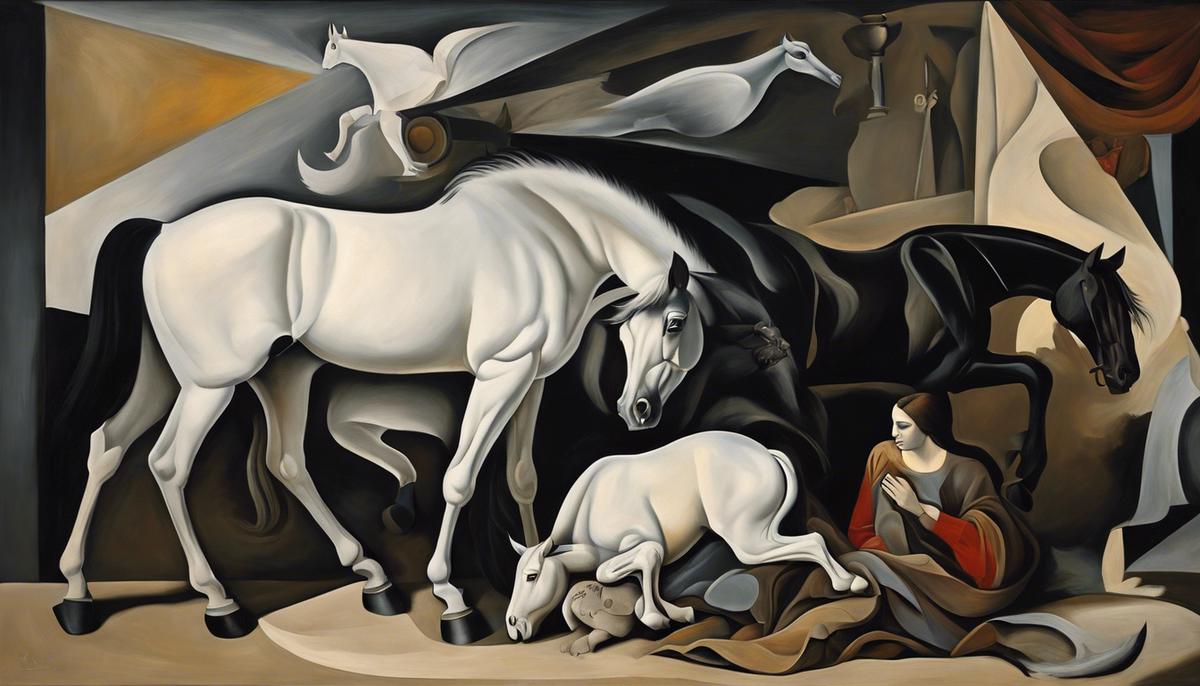As a testament to the afflictions of war and a fierce embodiment of Picasso’s fervent pacifist beliefs, Guernica remains one of the most potent political statements in the history of art. Its creation, embedded within a backdrop of devastating violence and civil discord during the Spanish Civil War, illuminates Picasso’s motivation and the emotional landscape from which Guernica sprang. This primal fusion of history and art catapults the viewer into a comprehension of the horror that unfolds within the painting’s boundaries. Furthermore, estranged from traditional encounters, Picasso introduces a language embedded with cryptic symbols each bearing a historical or cultural connotation that complements the painting’s substantial depth. However, Guernica is not just a painting; it’s an experience. The technique employed invites closer inspection, with particular emphasis on Picasso’s deft use of Cubism and Surrealism to emphasize the emotional impact.
Historical Background of Picasso’s Guernica
The Catalysts of History: Exploring Picasso’s “Guernica”
Pablo Picasso, known by many as one of the most robust figures of 20th-century art, leaves an indelible stamp on history with his masterpiece, “Guernica.” These striking greyscale murals, comprising disjointed human figures and symbols of suffering animals, echo resounding tales of a time marked with turbulence and tumult. Unveiling Picasso’s hidden inspirations demands a thrilling journey back in time, one that takes one through historical events that radically shaped Picasso’s artistic voyage.
Cast into the limelight of inspiration for “Guernica,” is the Spanish Civil War, an event seething with atrocities that shook the bedrock of Picasso’s native homeland. The savage bombing of the innocuous town of Guernica, by Nazi German and Italian Fascist airforces in April 1937, instigated the painter to wield his brushes with renewed fervour. This bellicose act, setting ablaze not only buildings but also the lives of innocent civilians, immensely disturbed Picasso. Manifesting this profound outrage and sadness, he channelled his creativity into forming a reaction against this egregious act of violence, thereby crafting “Guernica.”
As the symbol of Basque freedom, the town of Guernica held significant historical and cultural connotations. Its bombing, an attempt to obliterate the symbols of Basque tradition and freedom, stirred Picasso’s awareness of the human capacity for cruelty and violence, which heavily informed the themes of his masterpiece. With a penchant for breaking established norms, Picasso rejected the embellished, romanticised narratives of war. Instead, he sought to depict truth directly, employing cubist techniques to represent chaos and expose the brutality inflicted on the innocents.
Another profound source of inspiration can be traced back to the artist’s enduring concern with the Spanish bullfight, a recurrent motif across his work. Picasso’s understanding of the bullfight—an intricate tapestry of aggression, torment, and valour—offers critical insight into the potent power dynamics etched across the “Guernica” canvas. The bull, a symbol of primal force, and the horse, an emblem of suffering innocence in Spanish folklore, sketches the painful dichotomy of oppressor and oppressed in unparalleled precision.
Embedded within these significant episodes lies the inception of a masterpiece that resounds across generations. By decoding the historical inspirations behind “Guernica,” the observer can sense the interplay of Picasso’s personal experiences and societal upheavals. In an enigmatic blend of tragic reality and symbolic abstraction, Picasso’s “Guernica” emerges as a moving testament to a time painted by unrest and human suffering. It stands as an unequaled ode to peace by a fervent observer of life’s capacity for polychrome beauty, and its equally formidable potential for sombre periods of monochromatic desolation.

Photo by philipmyr on Unsplash
Symbolism in Picasso’s Guernica
Delving into the Darkness: The Strategic Use of Symbolism in Picasso’s “Guernica”
Moving beyond the historical context and initial exposition of the symbolism identifiable in Picasso’s magnum opus “Guernica”, one must magnify components within and comprehend them as key tools of expression. Coded symbolism was Picasso’s powerful vehicle in encapsulating the unutterable horrors of war and humanity’s inherent torment.
Ponder where one’s gaze first falls on the mural. Most likely, it is the intricately depicted wounded horse in the centre. In the realm of Picasso, representations do not conform to the usual exposition. The horse, in traditional Spanish culture, is a motif of nobility, courage, and freedom. But here it is twisted, writhing in agony. We feel its raw torment. Picasso seems to assert that war deforms the honourable, turning valour into victimhood.
Shift focus to the fallen soldier beneath the horse. Picasso denies him a hero’s portrayal. Rendered headless, his broken body an emblem of the crushed spirit, this soldier transforms from a symbol of bravery to an epitome of useless sacrifice. His shattered sword signals the futility of violence. Picasso skillfully uses this reversal of military symbolism to imbue viewers with a sense of utter despair, resulting from the senseless loss wrought by warfare.
Parallel to these interpretations, Picasso concentrates absolute despair in the delineation of innocent victims. The mother clutching her lifeless child, her outcry frozen in an eternal, silent scream, echoes globally renowned depictions of the loss of innocent life, such as Michelangelo’s “Pietà”. It borrows from religious iconography to solidify that while wars may be waged in the name of ideology or religion, it is always the innocent who pay the most profound price.
In contrast, look to the beacon of light—the oil lamp clutched by a seemingly terrified woman. It bursts through the chaos, encapsulating hope within the overarching terror. However, its brightness is harsh, almost blinding—perhaps indicating that hope itself comes with its own perils or uncertainties.
At the edges of Guernica, see the bull and the dove—quintessential symbols in Spanish Society—representing brutality and peace, respectively. Picasso disrupts traditional interpretations here. The bull, though typically exalted as brave or even heroic, appears nearly indifferent, embodying the impassive face of war. The dove, normally a symbol of peace, is entwined with a woman’s shattered body, illustrating how peace can be shattered in an instant by violence.
There is an undeniable starkness to “Guernica”′s symbolic language. A nearly monochromatic palette serves as the backdrop to these horrors, reinforcing the bleak message. Contrasted against the vivid usually associated with Picasso, this choice magnifies the painting′s grim theme, offering no comfort or refuge from the brutality laid bare.
In sum, Picasso’s exceptional manipulation of symbolism in “Guernica” demonstrates the stellar capacity of art to transmute the palpable horrors of war into universally recognisable visual cues. This extends an earnest invitation for humanity to question the futility of violence and contemplate the possibility of peace.

Artistic Techniques in Guernica
Following on from Picasso’s remarkable use of symbolism, Guernica presents a myriad of artistic techniques that effectively convey Picasso’s sombre message. Among these, the technique of fragmentation is quite prominent. Deconstructing the elements of the painting into geometric forms, Picasso shattered traditional visual coherence and invited the viewers to assemble their subjective meanings based on the broken forms.
Deliberately depriving the scene of any geographical specificity, the tables, animals, and humans appear against a ruminative vacuum. This dislocation further magnifies the theme of universal human suffering. By placing everyone and everything seemingly in the air, levitating, Picasso unanchors his subjects from the physical reality, creating a disquieting effect of disharmony and chaos.
Similarly, the large scale of the mural (349.3 x 776.6 cm) is another thoughtful technique applied by Picasso. The massive size contributes towards creating an overwhelming impact on the viewer. Emulating the vastness of a war’s overarching impact, the large scale broadcasts how immense tragedies echo beyond their immediate locations and epochs, encapsulating viewing generations in their resonating horror.
Furthermore, Picasso’s restrained use of colours in the mural illustrates the emotional desolation resulting from war. By limiting his palette to grays, blacks and whites, the artist channels a stark, mournful mood, inducing a chilling unease in the observer. The absence of colour not only reflects the bleakness and emptiness incited by horrific devastation, but it also strips the scene of sensuousness, reminding the viewer of the vapid reality of war.
Moreover, Picasso’s use of light and shadow dramatises the graphic nature of the scene. The sharp contrasts create a visual tension, mirroring the psychological stress that war inflicts. The central light source, represented by an electric bulb encompassed within an oil lamp, paradoxically casts more shadows than it illuminates, echoing the devastating fact that wars unveil more horrors than they resolve disputes.
Also, Picasso confronts the audience with the abstracted yet palpable suffering through the exaggerated and distorted features of the victims. The wide-open eyes and extended tongues do not just express the physical pain but also point towards the speechlessness and the stigma associated with the traumatic experiences of war.
All in all, Picasso’s innovative methods in Guernica transcend the conventional means of artistic expression, making it not just an iconic anti-war symbol but also a pioneer in modern art. The painting holds a mirror to the unending cycle of violence that human society perpetually struggles with, urging viewers to reevaluate the true costs of armed conflict. In essence, the message embedded in Guernica – that nothing justifies the infliction of agony and death on fellow beings – stands every bit relevant today.

Impact and Influence of Guernica
As art frequently echoes the societal and individual experiences of the artist, Picasso’s “Guernica” has unsurprisingly amassed significant scholarly and public attention for its piercing portrayal of war-induced agony. It indelibly shaped the discourse around war and violence in art and culture, becoming an eminently referenced source of artistic protest against inhumanity.
Post-“Guernica”, there was a discernible shift in how conflict, agony, and the human condition were depicted. Artists no longer felt tethered to illustrating pugilistic heroism or glorifying nationalistic fervour. Instead, an intense focus on the human dimension of warfare – the anguish, desolation and irrevocable loss – became more prominent in the genre of war art.
In a major departure from the existing oeuvre, “Guernica’s” fragmented, multi-angled perspective delivers a stark condemnation of the violence and its perpetrators. This revolutionary approach was evidence of a marked manipulation of conventional artistic norms, a testament to Picasso’s avant-garde instinct, and largely emboldened future artists’ exploration of war’s gruesome realities.
The essence of anonymity in “Guernica” further imbued the piece with a universal relevancy. By eschewing any geographical specificity, Picasso underscored the universality of suffering induced by warfare. This creative decision provocatively argued against the thinking that only immediate familial or regional ties justified empathy and outrage against such inhumanity.
The strikingly massive scale of “Guernica” and its monochromatic palette have influenced the conception of later war art. This trend has been characterised by the tendency of artists to leverage similar monumental styles and subdued palettes as a means to represent war’s all-encompassing psychic and emotional despair.
Additionally, Picasso’s ingenious use of light and shadow to reflect the psychological tension of war, and his depiction of victims with exaggerated, distorted features, had a palpable influence on subsequent depictions of war victims. This technique has underscored the abstracted yet unfathomable suffering that such cruelty inevitably inflicts.
Although decades have elapsed, “Guernica” continues to be as thought-provoking and relevant as ever, its unflinching reflectors of human pain and resilience continue to resonate and inspire discussion on both artistic and humanitarian levels. This timeless relevance is indeed evidence of “Guernica’s” impact and its unquestionable status as an iconic symbol against the atrocities of war. It indelibly asserts the critical message that no political, ideological, or territorial gains can justify the infliction of pain and death on fellow human beings.
The enduring influence of Picasso’s Guernica, both in the art world and beyond, attests to the indomitable power of art as a medium of dissent, social commentary, and catalyst for change.

Photo by vitorhugomonteiro on Unsplash
Arguably Picasso’s most influential artwork, Guernica, with its monumental size and profound subject matter, reverberates through the annals of art history, inspiring subsequent generations of artists and creatives. Its enduring legacy transcends the confines of a typical piece of art, becoming an emblem in protests against war and a rough-edged mirror reflecting the unforgivable scars civil discord etches on societies. Guernica’s true power lies in its ability to challenge authority, stirring public opinion and stimulating discourse on the cruelties of conflict and the desperate cries for peace. Thus, Picasso’s Guernica showcases its overwhelming relevance not only as a timeless piece of art but as a poignant reminder of the horrors of war and the incessant yearning for tranquillity.
























